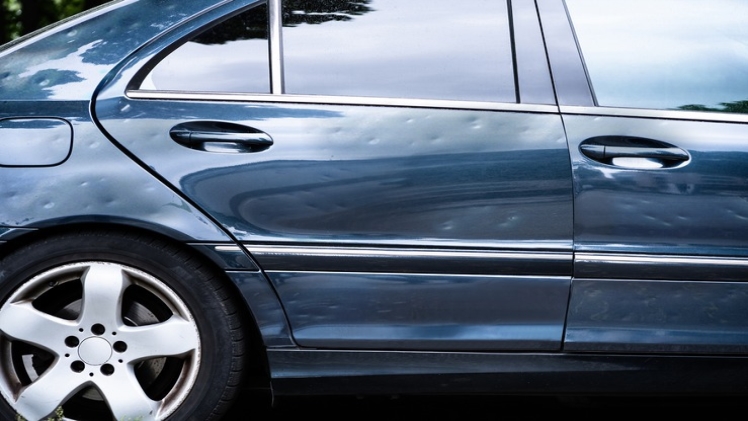Hail damage is the result of hailstones striking your vehicle’s surfaces with incredible force. These ice projectiles, often varying in size from small marbles to golf balls or larger, can leave a lasting mark on your car’s body. When hailstones hit your vehicle, they create dents and depressions in the metal and can even crack or chip the paint. The result is that your vehicle not only looks battered and bruised but also potentially suffers from diminished resale value.
In the aftermath of a hailstorm, prompt repair of hail damage is crucial. Hail damage is not just a cosmetic issue, it can compromise the structural integrity of your vehicle. Those harmless dents can weaken the metal, making it more susceptible to rust and corrosion over time. Neglecting hail damage can also lead to more severe issues, such as water leaks, which can damage your vehicle’s interior components. Therefore, addressing hail damage promptly is not about restoring your car’s appearance but more about preserving its longevity and safety on the road.
How Hail Can Cause Damage to a Vehicle’s Exterior?
The destructive potential of hail lies in the speed and force with which hailstones descend to the earth’s surface. Hailstones can fall at speeds of up to 100 mph or more, depending on their size and the storm’s intensity. When these ice pellets strike the exterior of a vehicle walkthroughsteps, they generate significant impact which is what causes damage to your car’s body.
The severity of the damage depends on several factors, including the size and density of the hailstones, as well as the angle and velocity at which they strike your vehicle. Large hailstones can create more extensive and pronounced dents, while smaller ones may cause subtle depressions.
Why Get Your Car Inspected by an Auto Repair Professional?
Assessing hail damage on your vehicle is a crucial step in the process of restoration. While it may be tempting to conduct a visual inspection on your own, enlisting the expertise of a body repair professional is highly recommended.
Hail damage can be deceiving. Some dents and imperfections may be barely noticeable to the untrained eye, but they can have far-reaching consequences if left unaddressed. A professional hail damage repair specialist possesses the experience and knowledge to spot even the most subtle forms of damage shayariway. Their trained eyes can identify issues that may be overlooked by you.
Moreover, professionals use specialized tools and techniques to assess the damage accurately. They can gauge the depth and extent of dents, evaluate the condition of the paint, and assess the structural integrity of your vehicle. By entrusting the assessment to a professional, you ensure that all damage is properly identified and addressed.
Hail Damage Repair Methods
When it comes to repairing hail damage, there are several methods at your disposal. Each approach has its unique advantages and is suited to different types and severities of damage. Some of them are:
- Paintless Dent Repair (PDR)
PDR is a highly popular and effective method for repairing hail damage. It involves the meticulous manipulation of dents from the inside of the body panel without the need for painting. This method preserves the vehicle’s original finish. - Traditional Repair
Traditional repair methods involve sanding, filling, and repainting the damaged area. While effective, this method can be more time-consuming and costly, as it requires refinishing the affected surface. - Paintwork
In cases of severe hail damage or extensive paint damage, repainting may be necessary. This process involves stripping the damaged paint, applying a new finish, and blending it to match the existing paint on the vehicle.
Preventing Hail Damage by Adding Hail-Resistant Materials
Here are some ways in which you can prevent hail damage on your vehicle by adding some hail-resistant materials to your vehicle:
- Hail-Resistant Roof and Hood
Some car manufacturers offer optional hail-resistant materials for the roof and hood of their vehicles. These materials are designed to withstand the impact of hailstones better than standard automotive materials. - Hail Guards for Windows
Hail guards are protective screens that can be installed over your vehicle’s windows. They act as a shield against hailstones, reducing the risk of window damage. - Hail-Resistant Films
Specialty films and coatings are available that can be applied to your vehicle’s exterior. These films provide an additional layer of protection against hail and can be particularly useful for older vehicles. - Hail-Resistant Covers
In addition to car covers, some companies manufacture hail-resistant covers specifically designed to withstand hail impacts. These covers offer an extra layer of protection when shelter is not available.
While these preventive measures can significantly reduce the risk of hail damage to your vehicle, it is essential to stay vigilant during hailstorms and take appropriate actions to protect your vehicle. By being proactive and prepared, you can minimize the potential impact of hail on your vehicle and maintain its pristine condition.

